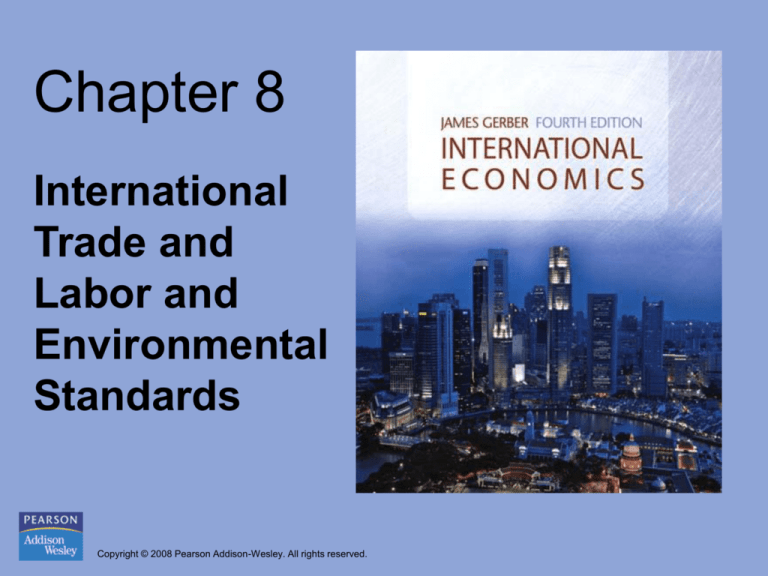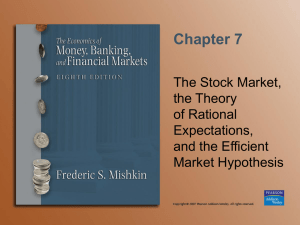
Chapter 8
International
Trade and
Labor and
Environmental
Standards
Copyright © 2008 Pearson Addison-Wesley. All rights reserved.
Chapter Objectives
• Discuss the remaining obstacles to international
economic integration: national laws, regulations, and
standards
• Analyze the relationship between trade flows and labor
standards, and between trade and environmental
standards
• Examine the usefulness of utilizing trade measures,
such as sanctions, to enforce certain standards
Copyright © 2008 Pearson Addison-Wesley. All rights reserved.
8-2
Introduction
• Since the end of World War II, many of the formal
barriers to trade have been removed
• However, unfettered flow of trade and deepening
integration are still hampered by differences in
– National laws and regulations
– National technical, health and safety, environmental, labor
standards, etc.
• These are often adopted for domestic reasons without consideration of
the effects on trade
Copyright © 2008 Pearson Addison-Wesley. All rights reserved.
8-3
What Solution for Differing
Standards?
• Most trade agreements and WTO commitments allow
for the combination of
– Harmonization of standards: two or more countries adopt a
common set of standards
– Mutual recognition of standards: countries maintain their
own standards, but accept the standards of others as valid and
sufficient
– Separate standards: countries maintain their own standards
and refuse to recognize the standards of others
Copyright © 2008 Pearson Addison-Wesley. All rights reserved.
8-4
What Solution for Differing
Standards? (cont.)
• No general rule determines which way of dealing with
the differences in standards is best for international
trade
• Each of the three mechanisms has advantages and
disadvantages
– Harmonization of technical standards, for example, leads to a
larger market and greater efficiency, but may also freeze
inferior standards into place
Copyright © 2008 Pearson Addison-Wesley. All rights reserved.
8-5
What Solution for Differing
Standards? (cont.)
• However, differences in labor and environmental
standards, in particular, has generated concerns
– High-income countries often fear that laxer standards in other
countries induce domestic firms to (1) adopt lower standards
to remain internationally competitive; or (2) move to
countries with lax standards
– Countries are feared to engage in a race to the bottom –
adoption of the lowest level of standards possible in order to
attract foreign firms
Copyright © 2008 Pearson Addison-Wesley. All rights reserved.
8-6
Trade Agreements and Labor and
Environmental Standards
• The U.S. and many other countries nowadays want labor and
environmental standards be included in any future trade
agreements
– U.S. trade agreements with Canada and Mexico (the North American Free
Trade Agreement, NAFTA) and with Jordan address labor and the
environment: each country must enforce its own standards or face
monetary fines
– Labor and environmental activists see fines as inadequate to enforce
standards and prohibit the race to the bottom, demanding the use of trade
sanctions
Copyright © 2008 Pearson Addison-Wesley. All rights reserved.
8-7
Labor Standards
• Five basic international labor standards proposed by the
International Labor Organization (ILO) and revised by
the Organization for Economic Cooperation and
Development (OECD)
–
–
–
–
–
Prohibition of forced labor
Freedom of association
The right to organize and bargain collectively
An end to the exploitation of child labor
Non-discrimination in employment
Copyright © 2008 Pearson Addison-Wesley. All rights reserved.
8-8
Labor Standards (cont.)
• The five standards are widely agreed upon, but also
ambiguous: what is meant by “exploitation”?
• Many potential labor standards are contentious:
universal minimum wage level, limits on the number of
work hours, workplace health and safety, etc.
– Low-income countries are reluctant to pay much higher
minimum wages: higher wages would reduce firm profits,
and result in closing down of production and a rise in
unemployment
Copyright © 2008 Pearson Addison-Wesley. All rights reserved.
8-9
Labor Standards and Trade
• Low- and high-income countries face very different sets of
economic constraints; harmonization of labor standards is thus
difficult
• Should one country, then, use trade sanctions to enforce certain
labor standards in another?
– Labor activists often favor the use of trade barriers to enforce standards
– Trade economists think such barriers are ineffective as an enforcement
mechanism and only spur protectionism, deadweight losses, and other
economic inefficiencies
Copyright © 2008 Pearson Addison-Wesley. All rights reserved.
8-10
Problems with the Use of
Sanctions to Enforce Standards
• Economists express four concerns over the use of trade
measures to enforce standards
1. Effectiveness: (a) only large countries or coalitions of
countries can use trade barriers successfully to enforce
standards, since small countries do not have a large enough
impact on global demand; (b) use of sanctions could be
counterproductive for boosting working conditions:
improved enforcement in the target country may cause
producers to shift to the unregulated and uninspected
informal economy
Copyright © 2008 Pearson Addison-Wesley. All rights reserved.
8-11
Problems with the Use of
Sanctions (cont.)
2. Hazy borderline between protectionism and
concern: special interests sometimes use the issue
of foreign labor standards in order to attain their
real goal, protection against foreign competition
• Producers in a high-income country with scarcity of
cheap, unskilled labor may seek sanctions against a lowincome country in order to counter the competition
posed by the low-income country producers with
abundant supplies of cheap labor
Copyright © 2008 Pearson Addison-Wesley. All rights reserved.
8-12
Problems with the Use of
Sanctions (cont.)
3. The specific content of labor standards: there is no
international agreement on the specific content and language
of labor standards
• Justifying the specific goal of sanctions to the international
community is thus difficult, and may lead to conflict in international
economic relations
4. The potential to set off a trade war: the use of sanctions is
discriminatory and thus an infraction of WTO rules
• Sanctions may cause retaliation from the targeted country, thus
further hurting international trade rules
Copyright © 2008 Pearson Addison-Wesley. All rights reserved.
8-13
Evidence of Low Standards as
Predatory Practice
•
Low standards are generally not an effective
mechanism to enhance competitiveness and attract
foreign investment
1. In theory, countries cannot simultaneously capture markets
(run a trade surplus) and attract foreign investment: trade
surplus implies capital outflows, not inflows
2. There is very little evidence that countries that lower labor
standards succeed in obtaining a comparative advantage in a
new line of production
Copyright © 2008 Pearson Addison-Wesley. All rights reserved.
8-14
Evidence of Low Standards as
Predatory Practice (cont.)
3. Low labor standards are not a successful means to
attract foreign investment: low labor standards are
correlated with unskilled, illiterate labor force and
lack of economic development (poor roads, ports,
telecommunications point of contention in
international trade, schools, and sanitation)
• Low labor costs are thus more than offset by the costs
implied by a lack of development
Copyright © 2008 Pearson Addison-Wesley. All rights reserved.
8-15
Trade and the Environment
• There is considerable overlap in the debates on labor
and environmental standards
– Proponents of including environmental standards in trade
agreements believe sanctions should be used to enforce such
standards
– Critics of sanctions have concerns about the ineffectiveness
of sanctions, the hazy borderline between protectionism and
environmental concerns, the lack of international definitions
of environmental standards, and the potential for trade wars
Copyright © 2008 Pearson Addison-Wesley. All rights reserved.
8-16
Non-Transboundary and
Transboundary Effects
• Three arguments by proponents of trade barriers to
enforce environmental standards
– Without adequate enforcement of standards, countries engage
in an environmental race to the bottom to boost industrial
competitiveness
– Lack of enforcement of standards in developing countries
induce dirty rich country industries to “export pollution”and
thus create pollution havens
– Poor enforcement leads to environmental problems that spill
over to another country
Copyright © 2008 Pearson Addison-Wesley. All rights reserved.
8-17
Analysis of Environmental
Effects 1
• Is there an environmental race to the bottom?
– Although high environmental standards reduce
industrial competitiveness, they raise national wellbeing and economically optimal levels of production
– Most countries have adopted tougher standards over
time. In order for race to the bottom to occur,
sectoral interests would have to be politically
powerful
Copyright © 2008 Pearson Addison-Wesley. All rights reserved.
8-18
Analysis of Environmental
Effects 2
• Do pollution havens attract foreign firms?
– Some dirty industries did move in the 1970s from
high-income countries to low-income ones
– However, there is no evidence that any country
competes successfully for investment n the basis of
lax environmental standards
Copyright © 2008 Pearson Addison-Wesley. All rights reserved.
8-19
Analysis of Environmental
Effects 3
• Do environmental spillovers occur?
– Transboundary spillover effects are frequent
– However, a successful use of sanctions to counter
them is possible only by a large country or a
coalition of countries, and may lead to trade wars
Copyright © 2008 Pearson Addison-Wesley. All rights reserved.
8-20
Enforcing Standards:
Alternatives to Trade Measures
• As long as there are large income gaps between
countries, differences in labor and environmental
standards are unlikely to disappear
• Seeking enforcement of standards through sanctions,
however, is often futile and harms international trade
• How, then, to enjoy the benefits from world trade while
resolving the conflicts over standards?
Copyright © 2008 Pearson Addison-Wesley. All rights reserved.
8-21
Enforcing Standards: Alternatives
to Trade Measures (cont.)
• Three ways of enforcing sanctions without
hurting international trade
– Labels for exports
– Requiring home country standards
– Increasing international negotiations
• Let’s examine the usefulness of each of these in
detail…
Copyright © 2008 Pearson Addison-Wesley. All rights reserved.
8-22
Labels for Exports
• Labeling: a certification process whereby a label is
attached on an exported good to indicate to consumers
that the good was produced under humane and
environmentally sound conditions
– The method is already in place in some instances: Cambodian
textile exports to the U.S., Starbucks coffee imports, etc.
– Problems: (1) Many countries resist labeling as an
infringement of their sovereignty and (2) consumers must be
convinced the label provides accurate information
Copyright © 2008 Pearson Addison-Wesley. All rights reserved.
8-23
Requiring Home Country
Standards
• Requiring home country standards: high-standard
countries can require their firms to follow home
country standards when operating abroad
– Pros: impedes the race to the bottom; avoids the problem of
high-income countries’ dictating standards
– Cons: addresses only firms of high-standard countries
• Low-country producers are not affected
• A high-standard country firm may outsource production to a lowstandard country producer
Copyright © 2008 Pearson Addison-Wesley. All rights reserved.
8-24
Increasing International
Negotiations
• International negotiations and debate on labor and
environmental standards could be increased
– ILO could be given a greater role and start, for example,
publicizing lack of compliance with labor standards
– New agreements and organizations could be created to
address environmental issues
• The WTO is not an environmental organization; however, it allows
international environmental agreements to develop their own
enforcement mechanism
Copyright © 2008 Pearson Addison-Wesley. All rights reserved.
8-25
Chapter 8
Chapter Art
Copyright © 2008 Pearson Addison-Wesley. All rights reserved.
TABLE 8.1 Income and Population by
World Bank Categories, 2004
Copyright © 2008 Pearson Addison-Wesley. All rights reserved.
8-27
TABLE 8.2 Income Levels,
Society, and Environment
Copyright © 2008 Pearson Addison-Wesley. All rights reserved.
8-28
FIGURE 8.1 Child labor, 5–14 age
group, 2004 (millions)
Copyright © 2008 Pearson Addison-Wesley. All rights reserved.
8-29
FIGURE 8.2 Percent of children
working, 5–14 age group
Copyright © 2008 Pearson Addison-Wesley. All rights reserved.
8-30







